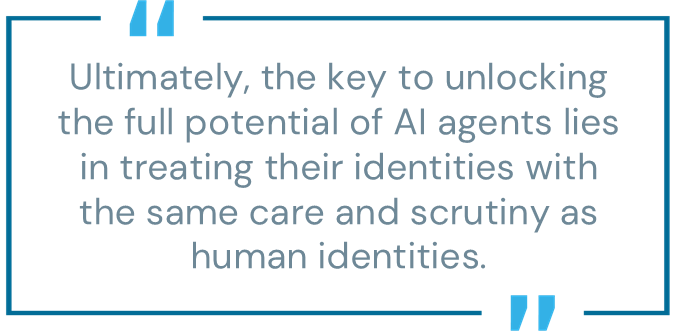
AI agents are on the rise. They can spin up, act independently, use tools, and make decisions—often without real-time human oversight. They promise incredible productivity but also introduce new risks and challenges that can’t be ignored. As these agents become more autonomous and integrated into enterprise operations, they blur the lines between human and machine responsibilities.
This raises critical questions: How do we ensure they act ethically? How do we secure their identities and access? And how do we manage their lifecycle to prevent misuse or unintended consequences?
It’s helpful to think about AI agents a bit like we think about people to fully comprehend the new risks they bring. They’re born. They learn. They collaborate. They lead. They retire (or should). And just like with humans, ensuring AI agents operate safely and ethically throughout their lifecycle is critical to your business, employees, customers, and reputation.
In this blog, we’ll walk through the “life” of an AI agent and compare it with a human life—from birth to death and beyond—to illustrate how identity security principles are critical to help enable their safe and trustworthy use.
What’s an AI agent?
AI agents are autonomous software entities powered by large language models (LLMs), capable of reasoning, decision-making, and tool use. They can be embedded in SaaS apps, launched from a browser, or run across dedicated agentic platforms.
For a deeper dive into how they work and where they’re used, check out our AI agent glossary page.

Secure beginnings: A safe environment for AI agent birth
Every agent is born somewhere—in a cloud platform, a dedicated agentic framework, a SaaS platform, or even a local browser and workstation. But wherever that happens, the environment needs to be inherently secure.
In neonatal departments, newborns are safeguarded through strict hygiene protocols, continuous monitoring, controlled access, and meticulous record-keeping. As with newborn babies, AI agents should be securely “born” into trusted, hardened environments with strong identity, authentication, access controls, and monitoring from the beginning. Just as a baby’s safety depends on sterile tools and vigilant care, an AI agent’s trustworthiness starts with a clean, well-governed foundation.
A security compromise in AI agent management consoles or agent-related configuration files can completely disrupt or maliciously influence everything agents do going forward.
Going to school: Learning from trusted data
Just like children go to school to learn essential skills, knowledge, values, and societal norms that shape their behavior and future contributions, AI agents must also go through a learning phase that defines how they interpret and interact with the world.
Once born, agents must “learn”—and what they learn from is critical. Their reasoning and behavior are shaped by the LLMs and fine-tuning data they inherit. Bad or biased data or poisoned training sets can lead to problematic agents with skewed decision-making, flawed assumptions, or exploitable logic.
And then there’s how AI agents interact with tools: They increasingly rely on APIs and function calls. Without proper guidance and guardrails, their first foray into “using tools” can lead to unintended actions—deleting data, triggering automation loops, or exposing secrets.
Securing this “educational” phase requires:
- Verified, trusted training data source
- Set boundaries for agents around which tools they can use
- Test and simulate AI agent behavior before going live
An untrained or mistrained agent represents a significant risk. Enterprises can’t afford to have thousands—if not millions—of unpredictable agents running within the environment.
Joining the community: Safe communication with others
AI agents don’t operate in a vacuum. They connect with people, with services and with other AI agents.
Just like humans don’t automatically trust each other—we rely on passports, ID cards, digital authentication methods, and real face-to-face recognition to establish authenticity—AI agents also need clear, verifiable ways to prove who they are and what they’re authorized to do.
This need for verifiable identity opens up a complex web of authentication and authorization needs. Without proper controls, an agent could impersonate another person or an agent, fall victim to deception just like people do, or leak data in unauthorized ways.
To facillitate safe collaboration:
- Mutual authentication is critical—via certificates, tokens, or secure APIs
- Agent-to-agent communication must be governed and logged, especially when the interactions are between two separate processes or agentic platforms.
- Delegation and consent frameworks help define what agents can do on behalf of others.
- Access controls for AI agents—as many AI agents represent people, it’s crucial to identify the person behind the operation, not just the agent process itself.
Getting a job: Becoming a responsible member of the enterprise
Employees are expected to contribute value, follow the rules, and act responsibly.
Just as employers create an identity for each employee—providing authentication mechanisms, defining roles, limiting access, and enforcing responsibilities—enterprises must do the same for AI agents.
For security and compliance, employee activities are tracked as they access systems and data—the same level of accountability must apply to agents.
Identities are therefore foundational for AI agents to operate securely within an enterprise.
These identities make it possible to:
- Apply fine-grained access controls for AI agents
- Track actions of AI agents through audit trails
- Enforce compliance and regulatory policies around AI agent activity
In the event of a security or operational incident, it’s essential to trace actions back to the specific AI agent responsible. Just like human behavior, AI agent behavior can be unpredictable—making accountability foundational to building enterprise trust and safely scaling to more ambitious agent-driven initiatives that could unlock even more value to enterprises.
Autonomy and leadership: When AI agents get promoted
Now it gets more interesting—and riskier.
Just like employees who demonstrate reliability over time are promoted into leadership roles with greater responsibility—managing budgets, approving contracts, or overseeing sensitive operations—AI agents will also be granted broader authority as they prove their value. But with increased trust comes increased risk, requiring stronger oversight, stricter access controls, and safeguards to prevent abuse or error.
Some agents will be designed to run entirely autonomously. Others will coordinate multiple systems, agents, and humans across workflows. These orchestration agents will act as virtual managers, making decisions with business-wide impact.
But the more autonomous the agent, the higher the stakes:
- Autonomous agents will no longer be tied to a human identity and will assume roles within the organization
- Privileges will expand to include high-risk and administrative actions across environments
- Failures and incidents could propagate across entire ecosystems
To secure autonomous behavior in AI agents, organizations must implement controls like:
- Privilege controls to help ensure least privileged, just-in-time (JIT) access to resources and services while all activity is closely monitored
- Behavioral analytics and anomaly detection for AI agent activities
- Automated ‘kill switch’ capabilities for emergency shutdown of compromised and malfunctioning agentic processes, minimizing impact and moving to backup (potentially manual) procedures
Agents will be the most powerful processes running in the enterprise and will require highly privileged access to perform their role.
Compromising an agent or the identity being used by the agent presents a significant risk to enterprises.
Death of an agent (or just retirement)
When employees retire or are let go, their access, credentials, and enterprise identities must also be deactivated. Temporary employees should only be given access during their tenure—not before, between or after.
The same practices should apply to AI agents, helping to make sure that when AI agents are not running, their identities, access and associated credentials are unavailable for use or even removed completely.
Inactive agents that retain access beyond their intended purpose become “zombie agents,” leaving dormant identities with live privileges exposed. This lingering access from zombie agents represents a significant attack surface that attackers can abuse.
This exposure is compounded when you think about scale—especially where it’s estimated that enterprises will have millions of agents, each performing various roles and built on separate systems and platforms. Excess permissions for any of these agents represent a weak link in the security chain.
Organizations will need scalable processes to remove access and decommission agents and their identities. These processes include:
- Credential and access revocation tied to the agent’s lifecycle
- Discovery mechanisms to locate and track all active and dormant agents
- Identity lifecycle management tailored for AI agents across every environment
Agent evolution: Passing the torch to future generations
Even after the process of an agent “dies,” its work lives on.
Whenever an agent runs, it typically adapts based on new information, changes in the environment, and past agent performance. It can also produce proactive but unexpected actions due to improved data sets, updated models, and more.
This evolution must be monitored and controlled, as it will ultimately impact the decisions and actions made by the agent.
New agents may:
- Produce unexpected behavior
- Continue flawed behavior from older logic and past agent executions and input
- Demand or require more privileges than intended initially
To maintain security and control throughout this evolution, enterprises must:
- Regularly review any changes to the model and data
- Implement controls described above to help ensure agents work within their allowed privileges and scope, and monitor their actions.
Securing the future of AI agents with lessons from human experience
As AI agents become integral to enterprise operations, their lifecycle mirrors that of humans in many ways—birth, learning, collaboration, leadership, and eventual retirement. By drawing parallels between the security needs of humans and AI agents, organizations can better understand the importance of identity security controls and lifecycle management for these powerful tools.
Taking a Zero Trust approach is essential. Just as we safeguard human identities with rigorous authentication, access controls, and monitoring, the same principles must be applied to AI agents. Every phase of an agent’s lifecycle demands robust security measures to prevent misuse, ensure accountability, and maintain trust, from their creation in secure environments to their retirement and beyond.
Ultimately, the key to unlocking the full potential of AI agents lies in treating their identities with the same care and scrutiny as human identities. By applying lessons from past experiences and implementing scalable, identity-focused security controls, organizations can safely harness the transformative power of AI agents while protecting their people, data, and reputation.
Yuval Moss, CyberArk’s vice president of solutions for Global Strategic Partners, joined the company at its founding.























